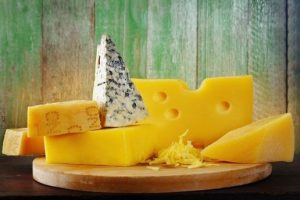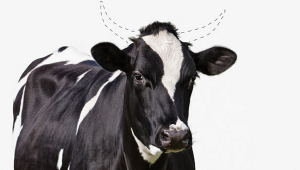Most people are familiar with just three types of “GMOs” corn, soy, and beets (usually they can even cite glyphosate resistance or the Bt trait!). But dozens of GMOs exist and they have been used to benefit human health, animal welfare, and to safeguard the environment for over 30 years. Here are some GMOs you may have never heard about, or realized why they were created in the first place!!!
1) Cheese — Do you eat cheese?! Who doesn’t!? Once upon a time, the veal calf industry was booming, and we used calf stomach rennet (enzymes that coagulate milk into curd) to make cheese. But as our concern for animal welfare grew, and our use of veal calves fell, we needed to find an alternate source of cheese-making enzymes. We now use bioengineered chymosin to protect the welfare of veal calves and to have a cheap and virtually limitless supply of enzymes, responsible for over 90 percent of cheese consumed today.

2) Insulin — For 60 years after the discovery that injected insulin could treat diabetes, diabetics relied on insulin purified from animals, primarily cattle and pigs. Animal insulin works well on the whole, but is not an exact match with the human hormone, and it sometimes causes adverse reactions, such as skin rashes. In 1978 insulin became the first human protein to be manufactured through biotechnology. Today all insulin for human use is manufactured from GM bacteria.
3) Vaccines — Indisputably life saving, vaccines are produced in chicken eggs, human cell lines, or bacteria, all genetically modified to produce the antigen of choice!
4) Golden Rice — This is a great example of improving a non-nutrient dense, staple food source that is heavily consumed in very poor countries. One hundred and ninety million children and 19 million pregnant women are at risk for vitamin A deficiency. The genes to make vitamin A in Golden Rice were transferred from daffodils, a bacterium, and maize.
5) Papaya — The entire papaya industry in the U.S. was nearly decimated by the papaya ringspot virus. GMOs saved the entire industry!
6) Potatoes — GMO potatoes were approved by the FDA last year. Potatoes naturally contain a precursor to acrylamide, a cancer-causing chemical that is produced when potatoes are cooked at high temperatures (just like we enjoy them, fried!). The gene was modified so the potatoes will produce less of the chemical precursor. Nothing was added, that is why they are called “Innate.” Additionally, a gene was modified to reduce bruising and browning. This was the same gene that was modified in the “Arctic Apple” (a variety of GM apple that doesn’t turn brown when it is cut). For those who are interested in an in-depth explanation, these potato varieties each involved transformation for two traits (the genes related to expression of black spot bruise and asparagine, and the genes related to reducing sugars in tubers) for a total of 10 events, which were done separately by RNAi (RNA Interference). Reducing food waste from bruising and browning will save hundreds of thousand of pounds of carbon emissions per year!
7) Interferon — A protein used to treat multiple sclerosis, autoimmune disorders, and in some cancer treatments. As a society we rely on drugs produced by GM bacteria!
8) Blood clotting treatments – For strokes, blood clots, and blood clotting disorders — example, the drug, ATryn, is an anticoagulant that reduces the probability of blood clots during surgery or childbirth. It is extracted from genetically modified goat’s milk.
9) Cotton — Fifty percent more cotton is produced worldwide today on the same amount of land as compared to 40 some years ago. Some countries have reduced their cotton insecticide use by up to 90 percent!!!
10) Salmon — It’s no secret that wild salmon populations have been overfished and stressed by climate change. Commercial fishing, and human-caused habitat destruction have contributed to the lowest salmon population observed since the 1970s. A new genetically engineered Atlantic salmon variety contains a gene from Pacific Salmon to increase the growth rate from the usual 3 years to 18 months. This and other technological advances, enables the fish to be grown on land, which could help us to build a U.S. based salmon industry (95 percent of our salmon is imported) and also help us to protect our oceans from over fishing.
GMOs in development
Some of my favorite GMOs currently underdevelopment include:
A “polled” (hornless) variety of dairy cattle: A stunning 9 million of which are currently deformed with hot irons, clippers, or caustic paste each year, causing much animal suffering (farmers hate doing it, too!). Hornless cows are lousy milk producers and traditional breeding has not been able to crossbreed a great milking and hornless variety. This technology works by disabling a gene, instead of adding one from another species. There are many other genetic modifications in development currently to reduce animal suffering!

The Florida Orange crop is currently being decimated by blight, a “citrus greening” plague sweeping through Florida. More than 80 percent of Florida’s orange trees are infected. A gene from spinach has been inserted into citrus trees to prevent this disease, and the citrus industry is only a few years away from complete collapse. However, approvals for new GMOs take a long time.
Spider silk from goats milk: Spider silk is tougher than Kevlar, incredibly light and resilient! But spider silk, as useful as it may be to industry, is very hard to farm from spiders (they cannibalize each other …).
Some persistent GMO myths
While we are at it, let’s also talk about some stuff I hate, m’kay?
“Genetic modifications are genes that are not found in nature.” False!!! These genes (every gene) are found somewhere in nature, for example, when a gene from spinach is put into citrus trees. Synthetic biology and the de novo creation of genes or proteins has not quite made it out of the lab yet :). Watch out for it though. It’s coming for you!
“Genetically modified wheat caused the rise of Celiac disease and gluten intolerance.” The fact is, there is no such thing as “GMO wheat.” Wheat has been modified by human hands since the dawn of agriculture. The only modifications that have been made have occurred through natural breeding. Not through bioengineering, i.e. the insertion or deletion of genes.
“Monsanto is making billions of dollars off the backs of poor farmers” False!!! Golden rice is distributed for free to subsistence farmers. Monsanto Co. was one of the first companies to grant free licenses for golden rice. The cutoff is $10,000 in profit — if farmers make more than $10,000 per year, then they are expected to buy the seeds.
And one more thing
I had always greatly disliked and objected to the demonization of Monsanto. Why do you think it is that “Monsanto,” “RoundUp,” “glyphosate,” and “Bt corn” are household names, while Syngenta and DuPont are not?
Exhibit A: Syngenta is a huge biotech seed and agri-chemical company — they manufacture Agrisure GM corn and triazine, one of the most widely used herbicides in U.S. and Australian agriculture. The Agrisure brand corn has the Viptera trait, to confer resistance to corn pests.
Exhibit B: DuPont Pioneer, a huge company (a subsidiary of DuPont) that shared the GMO corn market with Monsanto. Before Monsanto’s buyout by Bayer, they each own around 36 percent of it.
Genes engineered into DuPont Pioneer products include the LibertyLink gene, which provides resistance to Bayer’s Ignite/Liberty herbicides; the Herculex I Insect Protection gene which provides protection against various insects; the Herculex RW insect protection trait which provides protection against other insects; the YieldGard Corn Borer gene, which provides resistance to another set of insects;and the Roundup Ready Corn 2 trait that provides crop resistance against glyphosate herbicides.
(Not only that, but DuPont has manufactured its share of dangerous pesticides, herbicides, and other chemicals, including coatings like C8. By the way, DuPont also manufactured Agent Orange, DDT, and PCBs … just like Monsanto did (the old Monsanto chemical company — not the new seed company).
In conclusion, I love GMOs and biotechnology. We do this to help solve the world’s problems. If you are interested in GMOs check out a guest blog post I wrote on GMO basics, where you can find out what happens to DNA after we eat it, or you can watch me on YouTube (how embarrassing), or for more advanced info, check out another post I wrote on what types of technologies Monsanto is developing next.
Dr. Carol Lynn Curchoe is the founder of 32ATPs, and is a scientist, teacher, consultant, advisor, and author. You can find her on Twitter.



